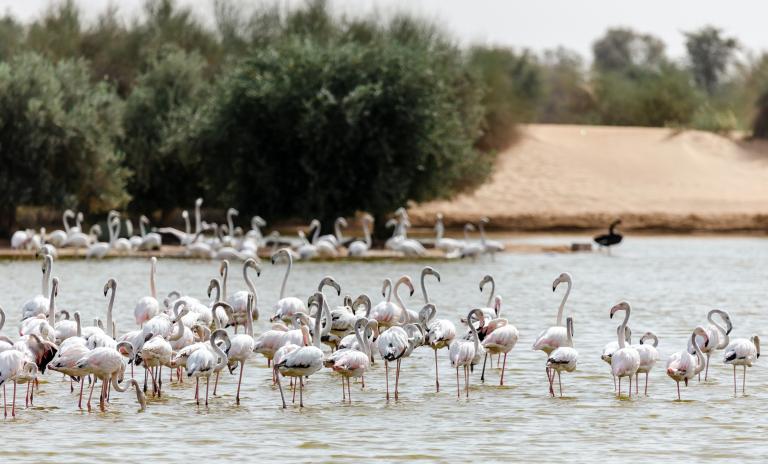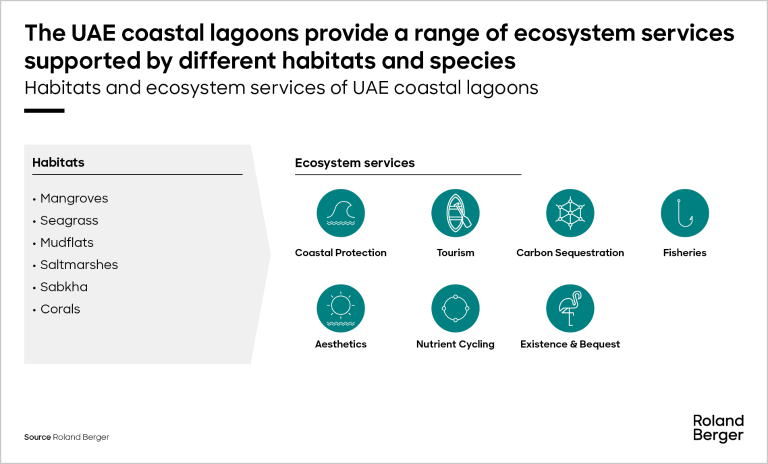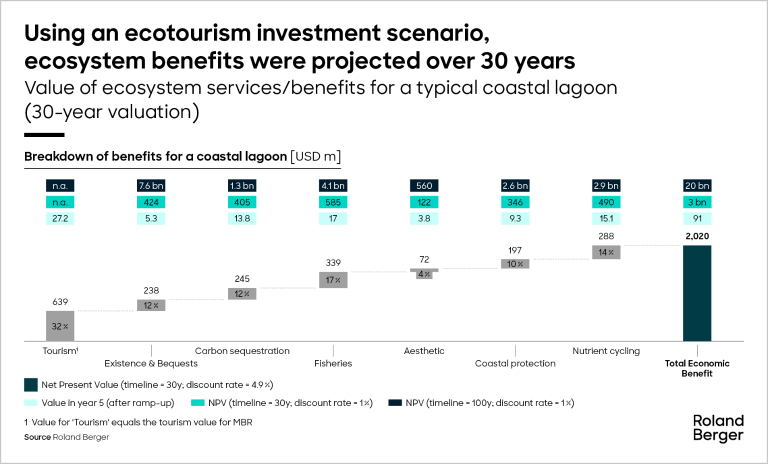Roland Berger advises public and private clients on the planning, financing, commissioning and maintenance of infrastructure.


Unveiling the economic value of ecosystem services in the UAE's coastal lagoons
By Karim Haggar
A focus on ecotourism
As part of a joint initiative with Emirates Nature-WWF, Roland Berger developed an economic model for the valuation of the ecosystem services provided by coastal lagoons in the UAE. This model points towards ecotourism as a promising scenario in which ecosystem services can increase over time, with both nature conservation and socio-development prospering and ultimately contributing towards a Sustainable Blue Economy.

In the United Arab Emirates, coastal lagoons occupy approximately 27% of the coastline and comprise key habitat types such as mangroves, seagrasses, and mudflats, which are of high importance for conservation.
Coastal lagoons with their rich habitats and biodiversity provide a wealth of benefits across climate change mitigation, coastal protection, biodiversity, food security, and exciting opportunities for economic growth such as ecotourism. The valuation of biodiversity and ecosystem services establishes a sound basis for sustainable policymaking and economic development. It creates a common language for conservationists, policymakers, and the business community.

"Partnering with Emirates Nature-WWF, we showcase the UAE's coastal lagoons to unlock ecotourism through biodiversity"
Measuring the value of ecosystem services
Currently, a number of different valuation frameworks coexist. For example, The Economics of Ecosystems and Biodiversity (TEEB) initiative and the Intergovernmental Science-Policy Platform on Biodiversity and Ecosystem Services (IPBES) offer guidance for conducting valuations. In addition, the UN developed the System of Environmental-Economic Accounting (SEEA) to support nations with the integration of nature into their accounting systems.
To operationalize these frameworks and support decision-makers with a practical tool to assess the true costs and benefits of planned developments, Roland Berger developed a five-step biodiversity and ecosystem services valuation approach with the following steps:
- Identify ecosystem services and habitat types relevant to the evaluation;
- Conduct a valuation of the identified ecosystem services;
- Develop scenarios and assess associated costs;
- Conduct a cost-benefit analysis to evaluate economic feasibility;
- Implement projects and monitor ecosystem services.
The exercise considered the valuation of both use and non-use ecosystem services. The use ecosystem services included carbon sequestration (or blue carbon), coastal protection, fisheries and aesthetics, while non-use values included the value people attribute to the existence of the flora and fauna of the coastal lagoon. The study’s scope focused on habitat types of high conservation value commonly found in the UAE such as mangroves, mudflats, sabkhas and seagrass.

Focusing on the merits of sustainable ecotourism
The economic model developed by Roland Berger consisted of developing valuation scenarios - including an ecotourism investment scenario in a well-managed and conserved area - that can achieve an increase in ecosystem services over time (as opposed to the other scenarios, including an inaction scenario as well as an urbanization scenario). The ecotourism investment scenario developed factors in the importance of conserving the natural area (i.e., protecting and sustainably managing natural ecosystems) and the development of sustainable ecotourism opportunities (i.e., developments and activities that do not harm existing natural ecosystems). Conservation and responsible travel must go hand-in-hand to achieve a positive impact on ecosystem services.
Recognizing the high intrinsic and tangible value of ecosystem services also increases the attractiveness of nature-positive ecotourism projects (including green infrastructure and conservation activities) against traditional development projects that deplete ecosystems and corresponding natural capital over time. The idea is, therefore, to demonstrate the economic potential of conservation and ecotourism and kickstart conversations with sustainability-focused investors.
Nature-positive and regenerative tourism, activities and practices that contribute to the restoration and rehabilitation of ecosystems while also providing economic benefits to local communities, are on a rising trajectory globally, and those who practice them are willing to pay more; ecotourism has emerged as one of the most important drivers of the global tourism market, valued at an estimated $200 billion in 2022 and making up nearly 10 percent of this vital economic sector. Ecotourism is projected to continue to grow at a rate of 12.9 percent annually during the next decade. The Chumbe Island private nature reserve in Zanzibar and the Basata Ecolodge on the Red Sea in Egypt are two stellar examples of success stories. Both projects have succeeded in adopting a high-value, low-volume approach and have developed an ecotourism offering that allows tourists and biodiversity to coexist in harmony.
This trend is also seen in the UAE, where there has been an increasing interest in nature-based tourism experiences. Ecotourism initiatives are consequently gaining traction across the emirates with new nature retreats on the rise, such as Casa Mikoko at the Mangrove Reserve in Umm Al Quwain, which offers eco-friendly stays, mangrove tours, and activities such as kayaking and kitesurfing, all while emphasizing sustainability and local engagement. Other examples include Dubai’s Hatta, which is being promoted as a destination for nature and ecotourism activities. When it comes to coastal ecotourism, the Khor Kalba Mangrove Centre in Sharjah is setting a strong example, offering tourists visits to the oldest mangrove forest in the UAE, with trees up to 8 meters tall.
The UAE is well positioned to further capitalize on the ecotourism opportunity to protect its coastal and marine ecosystems.
Enabling ecotourism development
A key step to further enabling ecotourism development is to understand the true value of ecosystems across the UAE’s coastal lagoons so that more accurate comparisons between development projects can be made.
Other important enablers include establishing protected areas to conserve the region’s natural heritage and enabling improved funding mechanisms and investment opportunities (e.g., biodiversity credits). These protected areas must be established alongside effective ecotourism management and monitoring to ensure long-term success and sustainability.
The valuation of biodiversity and ecosystem services and the informed assessment of ecotourism opportunities is part of a longer journey to conserve, protect, and regenerate our coastal ecosystems through Nature-based Solutions (NbS).
For these efforts to succeed and scale up, collaboration between public and private sectors, NGOs, local businesses, and communities is essential. Only with this collaboration can we achieve a blooming vision for the future – a thriving ecotourism sector that enhances conservation, supports local economies, and positions the UAE as a global leader in sustainable tourism.


